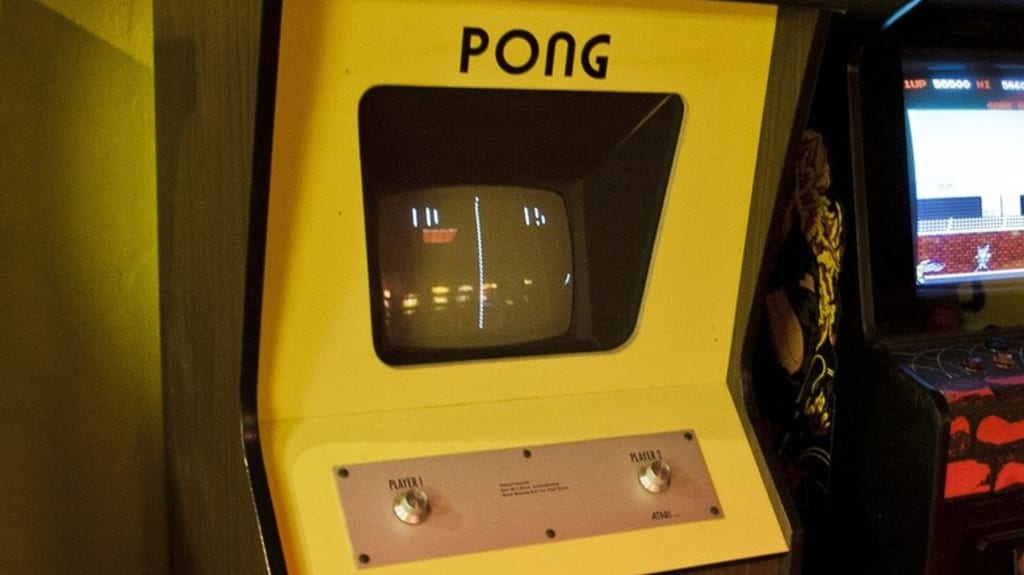Birth of Pong: The Game that Started it All
Pong: A Pioneering Odyssey into Virtual Entertainment

Pong: A Pixelated Ping Pong That Launched a Digital Galaxy
Imagine a time before joysticks and laser swords, before sprawling open worlds and pixelated dragons. Back in the early 1970s, entertainment was simpler, with pinball machines reigning supreme and television screens flickering with reruns and sitcoms. Then, like a rogue comet careening across the cultural sky, Pong arrived.
This unassuming game, a digital shadow play of table tennis, wasn't about intricate storylines or mind-bending boss battles. Its magic lay in its bare-bones brilliance: two rectangles chasing a bouncing dot on a black and white canvas. Yet, within this limited realm, a universe of joy was unleashed.
Nolan Bushnell, a dreamer with a twinkle in his eye and a thirst for innovation, envisioned a game that mirrored the ping-pong frenzy sweeping his local bar. He teamed up with Al Alcorn, a tech whiz with a talent for turning ideas into circuits, and together they birthed Pong.
The first prototype, cobbled together with wires and prayers, looked about as sophisticated as a toaster. But when it graced the bar's dusty countertop, something unexpected happened. Patrons, initially skeptical, became transfixed. Their hands danced on the crude knobs, their eyes glued to the bouncing pixel, their groans and cheers filling the air with a symphony of digital delight.
This wasn't just a game; it was a social experiment unfolding in real-time. Strangers became rivals, then buddies, united in their pursuit of pixelated glory. Pong's simplicity transcended age, skill, and even language. It spoke a universal language of competition, camaraderie, and pure, unadulterated fun.
Word of this digital phenomenon spread like wildfire. Soon, Pong cabinets sprouted like mushrooms across arcades, bars, and even bowling alleys. The public couldn't get enough of the pixelated smackdown. Quarters clattered into coin slots, joysticks sawed back and forth, and the world's first video game craze was born.
But Pong wasn't just about quarters and high scores. It was a cultural touchstone, a symbol of a new era where technology met entertainment in a vibrant, interactive dance. It graced magazine covers, inspired countless imitators, and even sparked lawsuits from table tennis purists who felt their beloved sport had been pixelated and plundered.
The game's development itself was a story of grit and ingenuity. The technology of the time was as cumbersome as a brick phone, and creating convincing graphics for a bouncing ball and two paddles was akin to painting the Mona Lisa with a crayon. Yet, Bushnell and his team, fueled by their passion and fueled by quarters, pushed the boundaries of what was possible.
One unforgettable incident became a legend in the gaming world. During a test run at Andy Capp's Tavern, the Pong machine malfunctioned, trapping the ball in an endless loop between the paddles. Instead of throwing a wrench, the patrons erupted in cheers. This "Pong moment," as it came to be known, demonstrated the unpredictable and often humorous nature of video games, adding a layer of charm that solidified Pong's place in the hearts of players.
Pong's impact transcended the pixelated screen. It became a cultural phenomenon, inspiring countless musicians, artists, and even toymakers. Its iconic soundscape, a bleep-bloop symphony of bouncing balls and scorekeeping chimes, became instantly recognizable. Pong merchandise popped up everywhere, from keychains to t-shirts, solidifying its position as a pop culture icon.
But Pong's true legacy lies in its role as the catalyst for a digital revolution. Its success paved the way for a tidal wave of innovation, birthing countless genres, studios, and iconic titles. From Space Invaders to Super Mario, from Halo to Minecraft, all owe a debt of gratitude to the pixelated pioneer.
The appeal of Pong wasn't in its complexity, but in its simplicity. It was a game for everyone, from seasoned gamers to wide-eyed newcomers. This accessibility broadened the gaming demographic, making it a pastime that transcended age, gender, and social barriers.
Today, decades after its birth, Pong's influence is still felt. From retro-inspired titles like Rocket League to the endless variations of the basic Pong concept, its DNA is woven into the fabric of gaming. Tournaments dedicated to the classic still draw passionate players, and references to Pong abound in popular culture, a testament to its enduring legacy.
Pong wasn't just a game; it was a gateway. It opened the door to a digital galaxy, where imagination could flourish and pixels could paint worlds of endless possibilities. So, the next time you boot up your console or grab your phone for a quick gaming session, remember the humble beginnings of Pong, the pixelated pioneer that started it all. It was a game born from a simple idea, played on a rudimentary screen, yet its impact echoed through the ages, forever changing






Comments
There are no comments for this story
Be the first to respond and start the conversation.